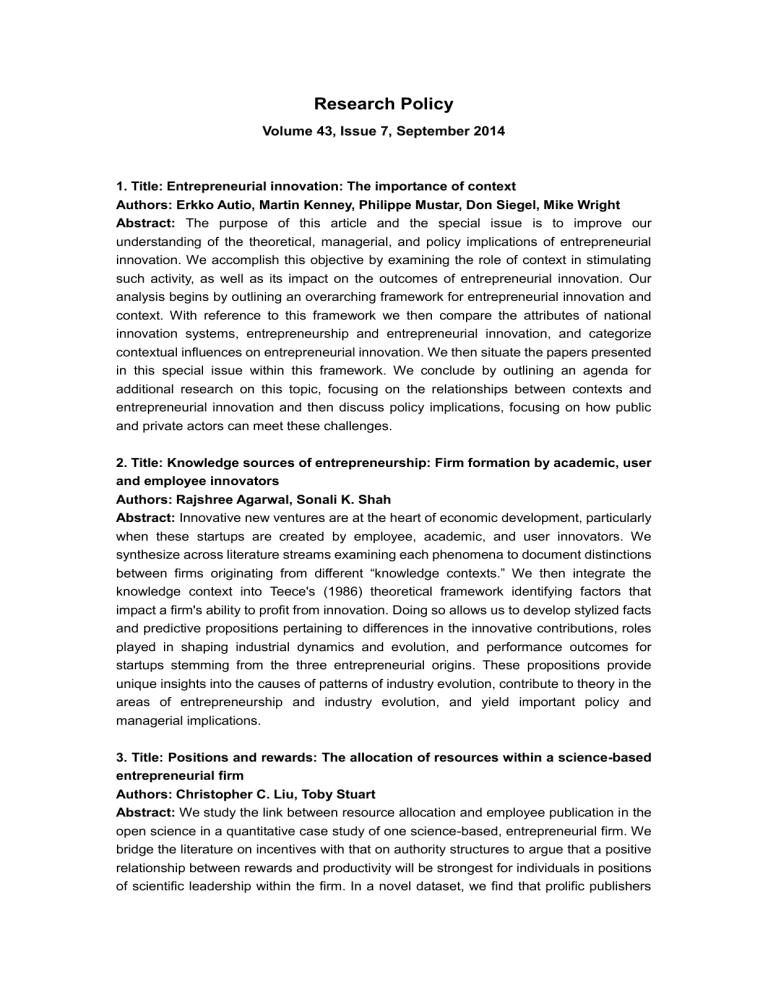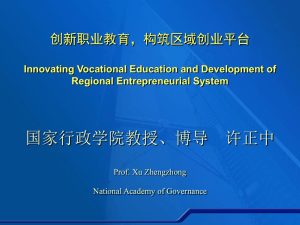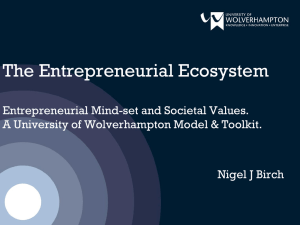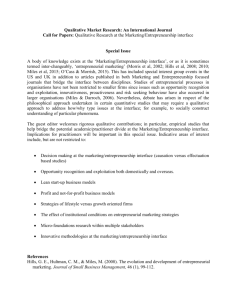Research Policy Volume 43, Issue 7, September 2014 1. Title

Research Policy
Volume 43, Issue 7, September 2014
1. Title: Entrepreneurial innovation: The importance of context
Authors: Erkko Autio, Martin Kenney, Philippe Mustar, Don Siegel, Mike Wright
Abstract: The purpose of this article and the special issue is to improve our understanding of the theoretical, managerial, and policy implications of entrepreneurial innovation. We accomplish this objective by examining the role of context in stimulating such activity, as well as its impact on the outcomes of entrepreneurial innovation. Our analysis begins by outlining an overarching framework for entrepreneurial innovation and context. With reference to this framework we then compare the attributes of national innovation systems, entrepreneurship and entrepreneurial innovation, and categorize contextual influences on entrepreneurial innovation. We then situate the papers presented in this special issue within this framework. We conclude by outlining an agenda for additional research on this topic, focusing on the relationships between contexts and entrepreneurial innovation and then discuss policy implications, focusing on how public and private actors can meet these challenges.
2. Title: Knowledge sources of entrepreneurship: Firm formation by academic, user and employee innovators
Authors: Rajshree Agarwal, Sonali K. Shah
Abstract: Innovative new ventures are at the heart of economic development, particularly when these startups are created by employee, academic, and user innovators. We synthesize across literature streams examining each phenomena to document distinctions between firms originating from different “knowledge contexts.” We then integrate the knowledge context into Teece's (1986) theoretical framework identifying factors that impact a firm's ability to profit from innovation. Doing so allows us to develop stylized facts and predictive propositions pertaining to differences in the innovative contributions, roles played in shaping industrial dynamics and evolution, and performance outcomes for startups stemming from the three entrepreneurial origins. These propositions provide unique insights into the causes of patterns of industry evolution, contribute to theory in the areas of entrepreneurship and industry evolution, and yield important policy and managerial implications.
3.
Title: Positions and rewards: The allocation of resources within a science-based entrepreneurial firm
Authors: Christopher C. Liu, Toby Stuart
Abstract: We study the link between resource allocation and employee publication in the open science in a quantitative case study of one science-based, entrepreneurial firm. We bridge the literature on incentives with that on authority structures to argue that a positive relationship between rewards and productivity will be strongest for individuals in positions of scientific leadership within the firm. In a novel dataset, we find that prolific publishers
receive greater year-end bonuses and are allocated additional direct reports, but this relationship only holds for individuals in scientific leadership roles. These results contribute to our understanding of resource allocation processes and reward structures in science-based firms.
4. Title: From the ivory tower to the startup garage: Organizational context and commercialization processes
Authors: Andrew J. Nelson
Abstract: An impressive literature documents how individual-level factors correlate with entrepreneurship and commercialization behaviors. We have far less insight, however, into how different organizational contexts may, in fact, play a dominant role in shaping these individuals and their behaviors. In this paper, I leverage a unique case of commercialization in which a largely overlapping team attempted to commercialize a technology in two different organizational contexts – first, in a university and later in a startup firm. By detailing the contextual features in each organizational environment and by linking these features to the participants’ differing approaches and attitudes toward commercialization, I extend the current literature through a demonstration of how organizational context shapes not only the initial decision to become an entrepreneur, but also the specific ways in which individuals interpret and act upon an entrepreneurial mission. More generally, I contribute to the literature on the commercialization of university research by highlighting some of the challenges inherent in adapting a context optimized for exploration to the task of exploitation.
5. Title: A theoretical analysis of the role of social networks in entrepreneurship
Authors: Dennis P. Leyden, Albert N. Link, Donald S. Siegel
Abstract: Entrepreneurship involves innovation and uncertainty. We outline a theory of entrepreneurship, which highlights the importance of social networks in promoting in novation and reducing uncertainty. Our findings suggest that this “social” aspect of entrepreneurship increases the probability of entrepreneurial success. The results also lend credence to theories of entrepreneurship that suggest that entrepreneurial opportunities are formed endogenously by the entrepreneurs who create them. We also consider the public policy implications of our findings.
6. Title: Creating value in ecosystems: Crossing the chasm between knowledge and business ecosystems
Authors: Bart Clarysse, Mike Wright, Johan Bruneel, Aarti Mahajan
Abstract: Policy makers take initiatives to stimulate knowledge ecosystems in technology hotspots. It is implicitly assumed that these ecosystems will lead to value networks through which the participating companies can realize a competitive advantage. Value networks refer to business ecosystems where the value proposition is offered by a group of companies which are mutually complementary. The strategy literature suggests that business ecosystems lead to competitive advantages for each of the partners in the ecosystem. Based on a unique hand-collected database of 138 innovative start-ups in the region of Flanders, we analyze the knowledge and business ecosystem and the financial
support network. We find that the knowledge ecosystem is well structured and concentrated around a number of central actors while the business ecosystem is almost non-existent at the local level. Further, we find that the financial support network is almost
100% publicly backed and fails to bridge the knowledge and business ecosystem. The implications for policy makers who tend to focus on the development of local ecosystems are discussed.
7. Title: Contextualizing entrepreneurial innovation: A narrative perspective
Authors: Raghu Garud, Joel Gehman, Antonio Paco Giuliani
Abstract: We review literatures that inform entrepreneurial innovation, paying particular attention to different conceptualizations of contexts. Early research explored micro and macro approaches with some scholars taking an actor-centric perspective and others a context-centric perspective. Bridging these perspectives, different scholars proposed multilevel approaches, arguing that opportunities are “found” or “made” by entrepreneurs whose efforts are moderated by contexts. More recent constitutive approaches, such as those informed by structuration, complexity and disequilibrium theories, have viewed entrepreneurial innovation as a process wherein actors and contexts are co-created. We add to constitutive approaches by examining how entrepreneurs contextualize innovation through narratives. A narrative perspective considers entrepreneurial innovation as an ongoing process involving embedded actors who contextualize innovation through performative efforts. We discuss the implications of this perspective for policy, entrepreneurs, and research.
8. Title: In good company: The influence of peers on industry engagement by academic scientists
Authors: Valentina Tartari, Markus Perkmann, Ammon Salter
Abstract: Previous research on academic entrepreneurship and engagement with industry has found that the behaviour of academics is influenced by their local social context. However, we know little about the mechanisms that produce this effect. We argue that academic scienti sts’ industry engagement is influenced significantly by the behaviour of their peers, that is, the behaviour of colleagues of similar seniority. Using insights from social psychology, we hypothesize that these peer effects are produced by the mechanism of social comparison. In an analysis of data from multiple sources for 1370 UK academic scientists and engineers, we find that peer effects are stronger for early career individuals and weaker for star scientists, suggesting the incidence of social comparison.
We argue that individuals look to their immediate peers for inspiration, because they view them as an important reference group and use them as a benchmark for their own ambitions and behaviours. Our findings have important implications for how universities may encourage scientists’ behaviours by paying attention to local work contexts.
9. Title: Beyond breakthrough research: Epistemic properties of research and their consequences for research funding
Authors: Grit Laudel, Jochen Gläser.
Abstract: The aim of this paper is to initiate a discussion about links between epistemic
properties and institutional conditions for research by providing an exploratory analysis of such links featured by projects funded by the European Research Council (ERC). Our analysis identifies epistemic properties of research processes and links them to necessary and favourable conditions for research, and through these to institutional conditions provided by grants. Our findings enable the conclusion that there is research that is important for the progress of a field but is difficult to fund with common project grants. The predominance and standardisation of grant funding, which can be observed about many
European countries, appears to reduce the chances of unconventional projects across all disciplines. Funding programmes of the ‘ERC-type’ (featuring large and flexible budgets, long time horizons, and risk-tolerant selection processes) constitute an institutional innovation because they enable such research. However, while the ERC funding and other new funding schemes for exceptional research attempt to cover these requirements, they are unlikely to suffice.
10. Title: Strategic interactions in public R&D across European countries: A spatial econometric analysis
Authors: Hakim Hammadou, Sonia Paty, Maria Savona.
Abstract: The paper adds to the existing literature on the determinants of government spending in Research and Development (R&D) by considering the role of strategic interactions among countries as one of the possible competing explanations, within a spatial econometric framework. We account for several factors affecting national levels of public R&D spending, including (i) the international context – i.e. Lisbon strategy; (ii) country characteristics – level of private R&D, GDP, trade openness and the National
System of Innovation; (iii) countries’ similarities in relation to (a) trade and economic size and (b) sectoral specialization. The analysis is carried out on 14 European countries. First, we find that factors traditionally affecting the level of public R&D expenditure, such as the scale of the national economy, trade openness, sectoral specialization and private R&D, significantly influence the level of public R&D in European countries between 1994 and
2006. Interestingly, the introduction of the Lisbon strategy does not seem to have affected changes in the levels of public R&D spending. Second, by using different weight matrices, we confirm the existence of strategic interactions in relation to R&D spending among
European countries with similar economic, international trade and sectoral structure characteristics, though not geographically close.
11. Title: Is small actually big? The chaos of technological change
Authors: Shih-Chang Hung, Min-Fen Tu
Abstract: In this paper, we develop themes from complexity and chaos theory that help to explain the technological change process. We apply two quantifiers, correlation dimensions and Lyapunov exponents, to examine the signs and degrees of chaotic technological dynamics. To illustrate our ideas, we study the development of electronic displays from 1976 to 2010, using patent data. The results of the chaos model are matched against the profiles of patent citations. Our analysis contributes to the development of a chaotic model of technological change.
12. Title: Bridging differing perspectives on technological platforms: Toward an integrative framework
Authors: Annabelle Gawer
Abstract: An integrative framework is proposed to advance management research on technological platforms, bridging two theoretical perspectives: economics, which sees platforms as double-sided markets, and engineering design, which sees platforms as technological architectures. While the economic perspective informs our understanding of platform competition, the engineering design perspective informs our view of platform innovation. The article argues that platforms can be usefully conceptualized as evolving organizations or meta-organizations that: (1) federate and coordinate constitutive agents who can innovate and compete; (2) create value by generating and harnessing economies of scope in supply or/and in demand; and (3) entail a modular technological architecture composed of a core and a periphery. In support of this conceptualization, a classification system is presented, indicating that technological platforms appear in a variety of organizational forms: within firms, across supply chains, and across industry innovation ecosystems. As an illustration, the framework is then applied to derive a simple model highlighting patterns of interaction between platform innovation and competition, yielding hypotheses that could be tested empirically by future scholars.
13. Title: R&D portfolios and pharmaceutical licensing
Authors: Junichi Nishimura, Yosuke Okada
Abstract: We examine how R&D portfolios of drug pipelines affect pharmaceutical licensing, controlling firm size, diversity, and competition. The data collected comprises
434 license-ins and 329 license-outs closed by 54 Japanese pharmaceutical companies between 1997 and 2007. We pay special attention to stage-specific licensing by dividing the innovation process into early and late stages. Joint estimates of license-in and license-out using seemingly unrelated regressions (SUR) reveal that drug pipelines significantly affect stage-specific licensing, inducing portfolio effect that lead to smoothing drug pipelines across early and late stages.
14. Title: M&A and R&D: Asymmetric Effects on acquirers and targets?
Authors: Florian Szücs
Abstract: We evaluate the impact of M&A activity on the growth of R&D spending and
R&D intensity of 265 acquiring firms and 133 merger targets between 1990 and 2009. We use different matching techniques to construct separate control groups for acquirers and targets and use appropriate difference-in-difference estimation methods to single out the causal effect of mergers on R&D growth and intensity. We find that target firms substantially decrease their R&D efforts after a merger, while the R&D intensity of acquirers drops due to a sharp increase in sales.






